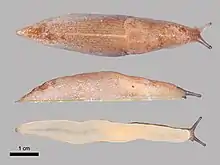| Tandonia kusceri | |
|---|---|
 | |
| Scientific classification | |
| Domain: | Eukaryota |
| Kingdom: | Animalia |
| Phylum: | Mollusca |
| Class: | Gastropoda |
| Subclass: | Heterobranchia |
| Order: | Stylommatophora |
| Family: | Milacidae |
| Genus: | Tandonia |
| Species: | T. kusceri |
| Binomial name | |
| Tandonia kusceri (H. Wagner, 1931) | |
| Synonyms[2] | |
| |
Tandonia kusceri is a species of slug belonging to the family Milacidae.[1][2][3]
Identification
Tandonia kusceri has the long keel continuing up to the mantle that is typical of the Milacidae and is pale pinky brown, usually with small black spots. It is thus liable to be confused with its close relative[4] Tandonia rustica, requiring dissection for reliable distinction. Tandonia kusceri is distinct from this and other Tandonia species in having a very long epiphallus, five or more times as long as the penis.[5] Another externally similar species is Tandonia serbica; it has been questioned whether it is truly distinct from T. kusceri.[6] Length of crawling individuals up to 100 mm.[6] Specimens preserved in alcohol lose the pink colouration.[6]
Distribution
The species is believed to be native to parts of the Balkans (Bulgaria, the European part of Turkey, northern Greece, North Macedonia, Serbia) and eastern Romania.[5] It has been introduced more widely:
- It was reported in the Odessa region of Ukraine already in 1902, which might or might not represent an introduction.[7] In 1998 it was observed in the Mykolaiv region and in 2004 in the Crimea. The first record from further west, in the Transcarpathian region, was in 2018, and it continues to spread further.[7][5]
- Croatia (garden in Dubrovnik) in 1972[8]
- Montenegro since 2000[9]
- Moldova since 2011[10]
- Slovakia since 2014[11]
- Samothraki Island in Greece since 2017[12]
- Hungary, widely distributed when first noted in 2019[13]
- Austria since 2020[14]
- In the Caucasus region, there are records from both Russia and Georgia (both in 2021).[5]
- In the USA it was reported from a Chicago garden in 2013.[15][3]
- In Canada, there are numerous records from Ontario from 2017 onwards.[5]
References
- 1 2 Dedov, I. (2017). "Tandonia kusceri". IUCN Red List of Threatened Species. 2017: e.T171518A1327560. doi:10.2305/IUCN.UK.2017-3.RLTS.T171518A1327560.en. Retrieved 16 August 2023.
- 1 2 "Tandonia kusceri (H. Wagner, 1931)". Fauna Europaea. Fauna Europaea Secretariat, Museum für Naturkunde, Berlin. Retrieved 16 August 2023.
- 1 2 "Tandonia kusceri (H.Wagner, 1931)". Global Biodiversity Information Facility. Retrieved 25 October 2021.
- ↑ Schallenberg, V.M.; Heim, R.; Schneppat, U.E.; Müller, P.; Rüetschi, J.; Neubert, E. (9 August 2022). "Revision of the family Milacidae from Switzerland (Mollusca, Eupulmonata, Parmacelloidea)". ZooKeys. 1116: 149–179. doi:10.3897/zookeys.1116.82762.
- 1 2 3 4 5 Balashov, I.; Markova, A. (23 January 2023). "Expansion of the invasive Balkan slug Tandonia kusceri (Stylommatophora: Milacidae): A new frontier in northern Ukraine and other new records". Folia Malacologica. 31. doi:10.12657/folmal.031.004.
- 1 2 3 Wiktor, A. "The slugs of Bulgaria (Arionidae, Milacidae, Limacidae, Agriolimacidae – Gastropoda, Stylommatophora)". Annales Zoologici. 37: 73–206.
- 1 2 Gural-Sverlova, N.; Gleba, V.; Gural, R. (2019). "Einschleppung von Tandonia kusceri (Pulmonata: Milacidae) nach Transkarpatien und Verbreitung von Tandonia-Arten in der Ukraine [Introduction of Tandonia kusceri (Pulmonata: Milacidae) in Transcarpathia and distribution of Tandonia species in Ukraine]". Malacologica Bohemoslovaca (in German). 18: 19–26. doi:10.5817/MaB2019-18-19. ISSN 1336-6939.
- ↑ Wiktor, A. (1982). "Contributions to the knowledge of the slugs of Yugoslavia (Arionidae, Milacidae, Limacidae, Agriolimacidae – Gastropoda, Pulmonata)". Annales Zoologici. 36: 466–489.
- ↑ Telebak, B.; Brajkovic, M.; Curcic, S. (2013). "Contribution to the knowledge of the slugs (Gastropoda: Stylommatophora: Limacidae and Milacidae) from Montenegro". Bulletin of the Natural History Museum (6): 55–64. doi:10.5937/bnhmb1306055T.
- ↑ Balashov, I.A.; Son, M.O.; Coadă, V.; Welter-Schultes, F. (5 September 2013). "An updated annotated checklist of the molluscs of the Republic of Moldova". Folia Malacologica. 21 (3): 175–181. doi:10.12657/folmal.021.021.
- ↑ Korábek, Ondřej; Čejka, Tomáš; Juřičková, Lucie (2016-06-30). "Tandonia kusceri (Pulmonata: Milacidae), a slug new for Slovakia". Malacologica Bohemoslovaca. 15: 3–8. doi:10.5817/MaB2016-15-3. ISSN 1336-6939.
- ↑ Georgiev, D. (2017). "Updated and corrected list of the inland molluscs of Samothraki Island (N Aegean, Greece)". ZooNotes. 113: 1–4.
- ↑ Turóci, Á.; Fehér, Z.; Krízsik, V.; Páll-Gergely, B. (2020). "Two new alien slugs, Krynickillus melanocephalus Kaleniczenko, 1851 and Tandonia kusceri (H. Wagner, 1931), are already widespread in Hungary". Acta Zoologica Academiae Scientiarum Hungaricae. 66 (3). doi:10.17109/AZH.66.3.265.2020.
- ↑ Duda, M.; Schubert, H.; Schindelar, J.; Haring, E. (2022). "Four new records of invasive gastropods in Vienna". Arianta. 9: 37–40.
- ↑ Gerber, J. (2014). "First American record of the exotic slug Tandonia kusceri (Gastropoda: Milacidae)". The Nautilus. 128 (2): 59–63.
